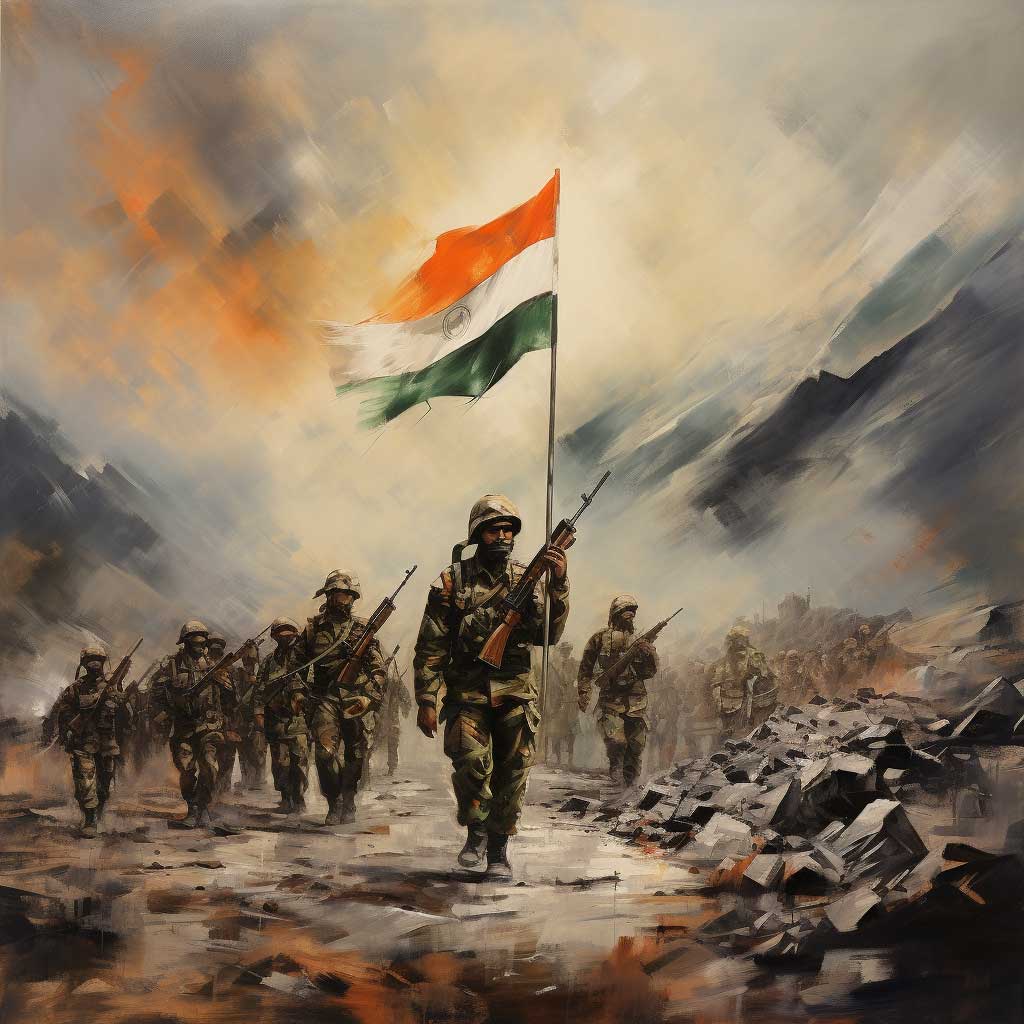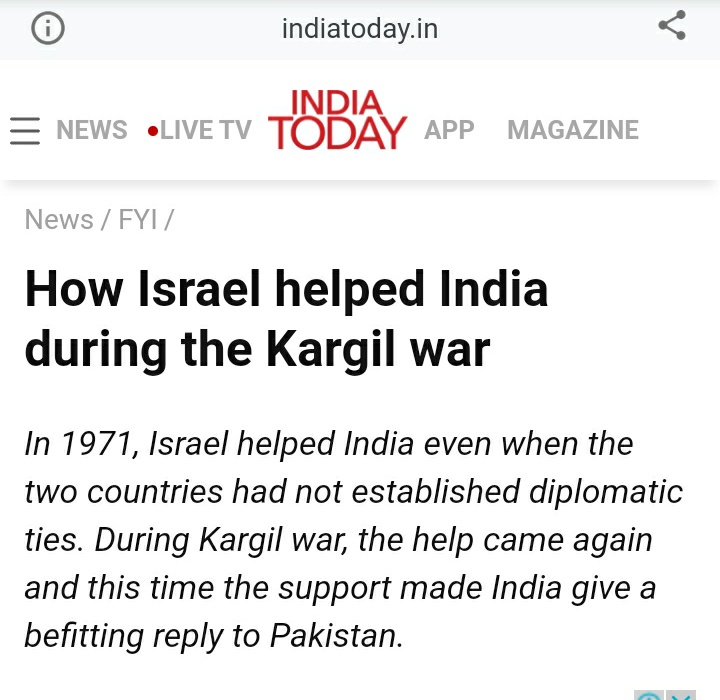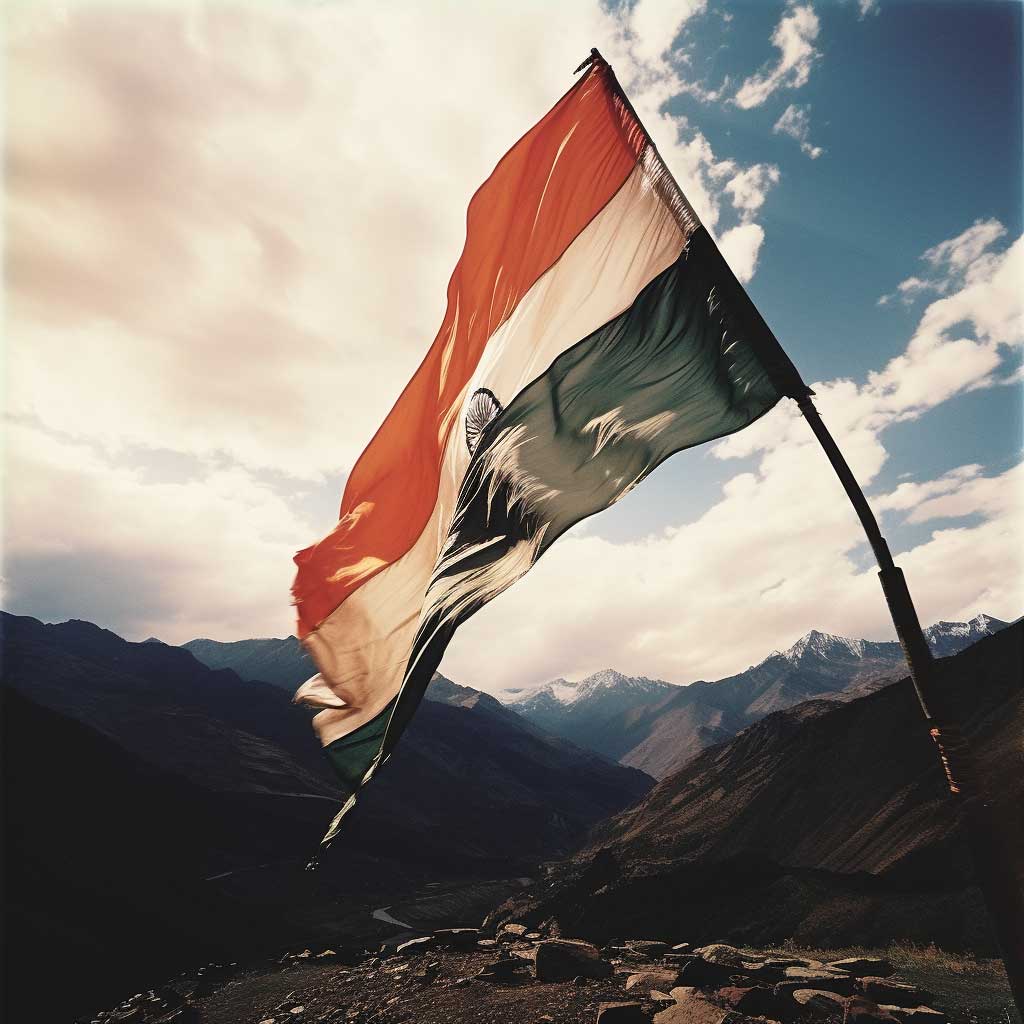Sanatan Articles
Satyaagrah
Written on
Satyaagrah
Written on
Satyaagrah
Written on
Satyaagrah
Written on
Satyaagrah
Written on
JOIN SATYAAGRAH SOCIAL MEDIA
21 years after Kargil, we reflect on how Israel's pivotal military support proved to be the game-changer, providing the edge India needed to hammer back Pakistani aggressors and emerge victorious, a conflict that marked watershed in Indo-Israeli relations

The 1999 Kargil conflict stands out as a defining moment in South Asian geopolitics, reshaping the military and diplomatic contours between India and Israel. Nicolas Blarel, in his book "The Evolution of India’s Israel Policy," notes how this high-altitude standoff led India to seek advanced military support from Israel, a move that signified a profound shift from the previous decades of relative peace following the Liberation of Bangladesh War in 1971.
The 1990s in India were marred by the emergence and escalation of insurgency in Kashmir, which eventually intensified into terrorism. Despite occasional skirmishes, it was the Kargil conflict that emerged as a watershed event. It tested India's military preparedness and highlighted deficiencies in crucial surveillance and warfare technology, prompting India to seek Israel's expertise in bolstering its defense capabilities. This partnership not only provided India with the necessary military support but also signaled a new era of Indo-Israeli strategic relations, with long-lasting implications for regional security and cooperation.
The Kargil conflict, a dramatic high-altitude confrontation between India and Pakistan, took place in the strategic Kargil-Dras sector of Jammu and Kashmir. In the spring of 1999, Indian forces were met with a grave challenge: Pakistani soldiers and mercenaries had occupied key positions on the heights, directly threatening the vital National Highway-1.
 |
This precarious situation unfolded as India faced international sanctions following the Pokhran Nuclear Tests in 1998, adding a layer of complexity to its strategic response. The situation was further complicated by the internal dynamics of Pakistan's leadership, with the operation being a unilateral initiative by General Parvez Musharraf, leaving Prime Minister Nawaz Sharif out of the loop. This clandestine maneuver by the Pakistani military not only heightened the stakes of the conflict but also exposed the fissures within Pakistan's governance, setting the stage for a tense and precarious military engagement in the region.
The skirmishes in the highlands of Kargil in May 1999 swiftly escalated, as India detected significant military incursions from Pakistan. The Indian military and intelligence agencies were initially blindsided by the extent of the infiltration, which marked the beginning of the Kargil War—a sharp provocation by Pakistan in the disputed state of Jammu and Kashmir.
It was a grueling week before the Indian army could fully grasp the enormity of the situation. After three painstaking weeks from the first signs of intrusion, the Indian forces commenced Operation Vijay, a robust counter-offensive aimed at reclaiming the lost territory. By July 1999, the invaders were pushed back beyond the Line of Control.
This conflict was unprecedented, signaling a chilling new era where two nuclear-armed states stood in open confrontation. The Indian army was compelled to rapidly adapt to this unconventional warfare, a stark departure from traditional combat strategies. Mindful of the precarious situation, Indian operations were meticulously contained to their side of the LoC, a calculated move to prevent a full-scale war between the nuclear neighbors.
The Kargil crisis, while culminating in a military and diplomatic triumph for India, sparked a critical introspection of its defense mechanisms and intelligence gathering. Pakistan's calculated infiltration into the rugged terrains of Kargil laid bare vulnerabilities in India's military oversight and its readiness for mountain warfare.
Amidst this turmoil, despite the absence of formal diplomatic channels, India found a strategic partner in Israel. The alliance proved crucial, as Israel's support played a pivotal role in countering the disadvantages faced by India. The conflict, spanning from May to July 1999, underscored an urgent need for India to revamp its intelligence infrastructure, refine its mountain combat proficiency, and enhance its precision strike capabilities.
Israel's timely intervention not only provided immediate relief but also set the stage for future advancements in India's defense posture. This collaboration marked the beginning of a new chapter in Indo-Israeli relations, with defense and intelligence cooperation at its core.
In the 1990s, Israel was already established as a global leader in border control, counter-terrorism, and conducting limited warfare—proficiencies that India urgently required during the Kargil conflict. Recognizing the need for a strategic shift, the BJP-led government, along with India's security establishment, saw an opportunity to deepen ties with Israel. The Israeli Defense Forces (IDF), with their extensive experience and technological edge in these domains, were well-positioned to provide the support India needed.
Although there is no conclusive evidence that Israeli assistance was the turning point in the Kargil war, Israel stood out as one of the few nations extending direct support to India in the midst of the crisis. The brief duration of the conflict meant that immediate military aid from Israel was limited. However, the aftermath of the Kargil conflict was a catalyst for change, highlighting critical gaps in India’s defense capabilities.
In the quest to bridge these gaps, the Indian security establishment engaged with Israel for its advanced military technology and expertise. This post-Kargil recalibration of India's defense strategy underscores a significant realignment, with Israeli cooperation becoming a cornerstone of India's efforts to fortify its military and intelligence apparatus.
During the Kargil conflict, Israel emerged as a pivotal ally, swiftly stepping up to supply India with critical military assistance. In this first phase of support, Israel's role was crucial in reinforcing India's military response by providing the Indian forces with essential mortar ammunition and, reportedly, laser-guided missiles for its fighter jets.
The Indian Air Force (IAF), tasked with providing close air support to ground troops, encountered significant challenges. The visibility of Pakistani bunkers was limited, unguided missiles proved inaccurate, and there was a strict directive to avoid crossing the LoC. To overcome these hurdles, Air Chief Marshal Tipnis made a decisive move on 30 May by deploying IAF Mirage 2000H fighters, equipped for delivering laser-guided bombs for precise ground attacks. Corroborated by various accounts, Israel's timely provision of laser-guided missiles enhanced the efficacy of the Mirages, enabling pinpoint strikes on the targets in the challenging terrain of Kargil. This swift and effective assistance underscored Israel's commitment as a reliable defense partner and signaled the deepening of strategic ties between the two nations.
The conflict dynamics shifted significantly in June 1999 when India's upgraded Mirage 2000H aircraft began precision strikes. These strikes effectively diminished the strategic advantage held by Pakistani forces entrenched in elevated positions, steering the tide of the conflict in India's favor. This turnaround was a testament to the technological prowess that Israel brought to India's arsenal.
Furthermore, the downing of an IAF Canberra PR57 on 21 May by a Pakistani Chinese-made Anza missile laid bare the vulnerabilities in India's reconnaissance capabilities. The incident underscored the limitations of traditional photo reconnaissance methods and highlighted the need for more advanced surveillance technology.
Amidst international pressure, Israel stood by India, expediting arms shipments that had been arranged prior to the Kargil conflict. This included delivering Heron and Searcher Unmanned Aerial Vehicles (UAVs), which provided a cost-effective yet advanced surveillance solution, offering high-altitude intelligence and more precise imagery for ground forces and fighter jets.
In a period marked by technological export sanctions against India, Israel's prompt and unwavering support not only bolstered India's immediate military needs but also cemented Israel's reputation as a dependable arms provider. This timely aid played a critical role in enhancing India's surveillance and reconnaissance capabilities during the Kargil conflict.
The integration of the Israeli Litening laser designator pod into Indian Air Force Mirage 2000 fighters proved to be a game-changer in the Kargil conflict. These pods, crucial for precision strikes, allowed Indian pilots to support Army troops engaged in grueling mountain warfare, enabling them to target enemy positions on high Himalayan peaks while adhering to the strict mandate of not crossing the LoC.
The Litening pod's technology is sophisticated yet straightforward: it emits an invisible laser beam, guiding bombs to their targets with lethal accuracy. On June 24, 1999, this technology was put to the test in a landmark operation. Wing Commander Raghunath Nambiar, aboard a Mirage 2000, deployed the Litening pod over Tiger Hill, successfully utilizing a laser-guided munition in combat for the first time in the history of the Indian Air Force. This mission, which saw the Wing Commander firing a total of five laser-guided missiles at Pakistani positions, was a turning point in the conflict.
Air Marshal Raghunath Nambiar's reflection on the operation captures the sentiment of the moment. Witnessing the target erupt in a "soundless explosion" through the video feed was a profound moment of success and relief for the Indian forces.
Reflecting on the operation's success, Air Marshal Raghunath Nambiar expressed profound satisfaction, stating, "Our joy knew no bounds as the entire video image of the target burst out into a soundless explosion." This triumph was not just a demonstration of the Litening pod's capabilities but also emblematic of the strength of Indo-Israeli defense cooperation.
India’s response to the Kargil conflict was twofold.
 |
| Israel helps us unconditionally, be it during the Kargil war or after the Pulwama attack, |
Initially, the crisis underscored the urgent need for a comprehensive review of the nation's defense capabilities. The conflict catalyzed a series of policy reforms aimed at addressing the glaring gaps that had been exposed. The first significant realization was the inadequacy of intelligence mechanisms. The Kargil Review Committee Report, a crucial public document, laid bare the deficiencies within India's intelligence equipment and practices, particularly the failure to predict cross-border infiltrations in Kargil. The intelligence community had placed undue confidence in the natural barriers of the region, which historically had been devoid of such Pakistani incursions, resulting in a lack of rigorous surveillance along this critical stretch of the LoC.
The aftermath of the conflict spurred a concerted push to overhaul military, intelligence, and technological strategies, ensuring enhanced preparedness against any future incidents akin to Kargil. The second takeaway from the conflict was the imperative to upgrade the military arsenal. The evolving security threats in the region, coupled with Pakistan's acquisition of advanced American military hardware, necessitated India to reassess and enhance the quality of its own armaments. This period of introspection and action laid the groundwork for a fortified national defense posture, aligning with the changing geopolitical landscape.
Operation Safed Sagar marked the Indian Air Force's (IAF) first high-altitude military operation, challenging the capabilities of both aircraft and missiles at the daunting elevation of nearly 16,000 feet at Tiger Hill. This unfamiliar terrain demanded an unprecedented level of adaptation and technical precision.
 |
The IAF faced initial hurdles in target engagement due to the absence of suitable guidance systems for the MiG-27s and MiG-21s. The introduction of the Litening targeting pod, along with the 1,000-pound laser-guided bombs, was a critical advancement, though integrating this technology was complex for the IAF, which had limited experience in such high-tech warfare.
To address these challenges, Israeli defense experts joined forces with the IAF's Aircraft and Systems Testing Establishment (ASTE), working diligently to modify the Mirage 2000's software and complete the Paveway bomb kit, which was hindered by US sanctions. Through close collaboration, the issues were swiftly resolved, significantly enhancing the IAF's operational efficiency.
Israel's support extended well beyond the immediate conflict, as evidenced by the continued use of advanced Israeli surveillance and reconnaissance equipment along the LoC. UAVs like the Searcher and Herons, which have become integral to India's border security apparatus, are a testament to the enduring legacy of Indo-Israeli defense cooperation that was solidified during the Kargil conflict.
reconnaissance capabilities, particularly along the LoC. The Indian military recognized the potential of drones in early detection of intrusions, a realization that came into sharp focus given the delayed spotting of infiltrations during the conflict. By the year 1999, India's own UAV development projects, including the Lakshya and Nishant models, were facing production delays and technical hurdles, with the former being in limited numbers and the latter still in testing phases.
In response to these setbacks and the urgent need for effective surveillance tools, the Indian military turned to the advanced and reliable technology of Israeli Searcher and Heron drones. These UAVs offered a sophisticated and immediate solution, providing the range and capabilities India required to compensate for its indigenous UAV development challenges.
Moreover, India's endeavors to establish its Airborne Warning and Control Systems (AWACS) suffered a significant blow when a prototype Avro aircraft, equipped with a domestic surveillance platform, crashed in January 1999, tragically resulting in the loss of eight scientists and the aircrew. This incident led to the suspension of the project and highlighted the acute need for airborne surveillance assets.
In the absence of AWACS, the Indian Army and Navy increasingly depended on UAVs for their surveillance operations. The pivot towards Israeli drone technology was not just a stopgap measure but a strategic decision that would significantly upgrade India's reconnaissance capabilities and shape its defense strategy for years to come.
Post-Kargil, the Indian military's strategic forecast identified the need for an extensive fleet of UAVs to enhance tactical and operational surveillance. An ambitious projection was set for acquiring 100 tactical UAVs for immediate deployment, along with an additional 200 UAVs for diverse altitude operations within the subsequent five years.
The Indian Ministry of Defence, understanding the urgency and scale of this requirement, secured a fixed-price deal in 2001 with Israel Aerospace Industries (IAI) at the cost of $7.2 million per UAV. In 2003, this partnership deepened with a $130 million contract for 18 Heron UAVs, with an order following for 16 more. IAI further cemented its relationship with India's defense infrastructure by collaborating with Hindustan Aeronautics Limited (HAL) for maintenance support.
The critical gap left by the lack of AWACS technology propelled the Indian government to engage with Israel on acquiring the advanced Phalcon radar platform. Additionally, India reportedly procured sophisticated sensors from Israel, bolstering its capabilities to monitor cross-border activities effectively.
The aftermath of the Kargil conflict saw a paradigm shift in India's border surveillance strategy. With a steady eye on potential infiltrations, the Indian army has since relied on the persistent vigil afforded by Israeli-made Searcher and Heron UAVs and sensor equipment, ensuring a robust defense posture along its borders.
|
The Kargil conflict, while predominantly an air and ground engagement, also had significant naval dimensions in the Arabian Sea. Though direct naval confrontations were averted, the Indian Navy was galvanized into high alert due to Pakistan's military build-up. As a strategic counter, the Indian Navy readied for a possible blockade of Pakistani ports to disrupt supply routes, an action aimed at coercing a Pakistani withdrawal from Kargil. This show of force by the Indian Navy seemingly played a role in dissuading Pakistan from initiating naval operations.
However, the situation prompted serious contemplation within the Indian naval hierarchy about the implications of a full-scale naval conflict. There was particular concern over the potential use of American-supplied Harpoon missiles by Pakistan under the pressure of a blockade. Additionally, the urgency for advanced defense capabilities was underscored by the delays in India's indigenous anti-missile defense (AMD) systems becoming operational.
In response, a committee led by Vice-Admiral Arun Prakash, then Chief of Naval Personnel at Naval Headquarters, was established to negotiate the acquisition of an AMD system. The result was the procurement of the Barak-I AMD systems and missiles from Israeli firms IAI and Rafael, finalized in February 2001. The experiences and strategic assessments following the Kargil conflict were pivotal in the decision to enhance the Indian Navy's capabilities, setting a new trajectory for India's maritime defense strategy.
The late 1990s saw a landmark defense procurement by the NDA government, with the purchase of the Barak-1 vertically launched surface-to-air missiles from Israel. This $270-million contract not only represented a significant technological advancement but also stood as the largest defense deal between India and Israel at the time.
By the early 2000s, the Indian defense establishment had effectively persuaded the government that Israel was well-equipped to fulfill India's niche technology needs in areas such as UAVs, surveillance systems, and anti-missile systems. This trust was placed in the context of the Defence Research and Development Organisation's (DRDO) struggles to produce operational UAVs, AWACS, and AMD systems in response to evolving security threats.
The aftermath of the Kargil conflict served as a critical juncture for India's defense strategy. It opened a window of opportunity for the Indian defense establishment to advocate for the Israeli defense industry as a capable and timely provider for India's urgent security needs. In the wake of Kargil, previously existing ideological and institutional reservations regarding deeper defense cooperation with Israel began to wane, setting the stage for a new era of robust defense relations between the two countries.
The Kargil conflict indeed marked a strategic inflection point for India, compelling a reevaluation and overhaul of its defense posture. The challenges encountered during the conflict laid bare the pressing deficiencies in intelligence, military capabilities, and equipment. The exigencies of the situation prompted the Indian government to deepen its defense cooperation with Israel, seeking assistance in areas where India's requirements were most critical.
In conclusion, the Kargil conflict and its subsequent developments were pivotal in transforming the defense relationship between India and Israel into a close-knit partnership. It was in this crucible of conflict that Israel proved to be a friend in need, indeed—a reliable ally that stood with India during a challenging time. The collaboration that blossomed in the shadow of the Himalayas laid the groundwork for a robust strategic alliance, one that would see Israel become one of India's top defense partners. The bonds forged in the urgency of warfare have since flourished into a comprehensive defense relationship, encompassing a vast array of technologies and systems crucial for India's security. Israel's readiness to provide cutting-edge military hardware, crucial intelligence support, and shared expertise was not just a demonstration of its commitment but also a testament to the mutual trust and respect that define the Indo-Israeli partnership. The legacy of Kargil has thus become a cornerstone of India's strategic modernization, with Israel playing a key role in enhancing India's defense capabilities and preparedness.
 |
 Support Us
Support Us
Satyagraha was born from the heart of our land, with an undying aim to unveil the true essence of Bharat. It seeks to illuminate the hidden tales of our valiant freedom fighters and the rich chronicles that haven't yet sung their complete melody in the mainstream.
While platforms like NDTV and 'The Wire' effortlessly garner funds under the banner of safeguarding democracy, we at Satyagraha walk a different path. Our strength and resonance come from you. In this journey to weave a stronger Bharat, every little contribution amplifies our voice. Let's come together, contribute as you can, and champion the true spirit of our nation.
 |  |  |
| ICICI Bank of Satyaagrah | Razorpay Bank of Satyaagrah | PayPal Bank of Satyaagrah - For International Payments |
If all above doesn't work, then try the LINK below:
Please share the article on other platforms
DISCLAIMER: The author is solely responsible for the views expressed in this article. The author carries the responsibility for citing and/or licensing of images utilized within the text. The website also frequently uses non-commercial images for representational purposes only in line with the article. We are not responsible for the authenticity of such images. If some images have a copyright issue, we request the person/entity to contact us at This email address is being protected from spambots. You need JavaScript enabled to view it. and we will take the necessary actions to resolve the issue.
Related Articles
- Valiant Marathas and the far-reaching effects of the loss of 3rd battle of Panipat: Jihad of the temple destruction
- Saraswathi Rajamani, at 16, became the youngest and first female spy for INA, boldly recruited by Netaji in 1942, courageously spent two years spying on the British in Myanmar during WWII, a pivotal yet overlooked heroine in India's struggle for freedom
- We also have views on other people's human rights, particularly when it pertains to our community," Jaishankar retorted in one of the strongest repudiation of the constant American lectures on human rights
- Was Italian family of Sonia Gandhi involved in the Bofors scam: Papers long buried, questions that were never asked
- Rare footage of Pakistan Army surrendering to Indian Armed Forces after the humiliating defeat in 1971 war: Vijay Diwas
- Can Communism and Democracy Coexist - 100 Years of Russian Revolution
- Taimur was attacked and defeated by 20 year old Rampyari Gurjar and her army of 40,000 women
- Saam Daam Dand Bhed: How Indira and Sanjay Gandhi pulled off the Maruti scam
- "Respect is earned, not given": Italy unveils unique memorial to honour valour & sacrifice of Indian soldiers during World War II for their significant role in liberating Italy, and the enduring gratitude and respect in the hearts of the Italian populace
- “It is not the honor that you take with you, but the heritage you leave behind”: Greek historian Megasthenes' Indica provides a historical account of ancient India, offering glimpses into its geography, society, governance, religion, economy, and culture
- Delhi skies echoed with the sound of roaring engines as @airindia 1139 descended, bringing home 212 Indians from war-torn Israel, chants of 'Vande Matram' & 'Bharat Mata Ki Jai' resonated, celebrating Operation Ajay's triumph for India, that is Bharat
- Winston Churchill's hate for Indians caused millions of deaths: A villainous supremacist
- "The formidable power of geography determines the character and performance of a people": Fascinating map of all the places of ancient India as mentioned in Mahabharata, put on display in Purana Qila, which is the ancient Indraprastha of Mahabharata
- Narasimha Rao govt brought places of Worship Act as a hurdle in reclaiming ancient Hindu heritage destroyed by Muslim invaders
- Bhagwan Parashurama – Chiranjeevi Avesha avatar of Bhagwan Vishnu





















